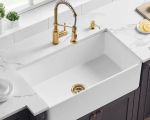- 1-Preparing-for-Water-Softener-Installation
- 2-Tools-and-Materials-Needed-for-Installation
- 3-Step-by-Step-Installation-Process
- 4-Common-Challenges-and-Tips-for-Success
- 5-Benefits-of-a-Proper-Water-Softener-Installation
1. Preparing for Water Softener Installation
Installing a new water softener in your home is an excellent way to improve water quality by reducing hardness caused by minerals like calcium and magnesium. Before beginning the installation, it’s important to assess your home's plumbing system and water usage to choose the appropriate water softener model. Understanding the location for installation, typically near the main water supply line, ensures effective softening for the entire household.
Additionally, turning off the main water supply and draining existing pipes helps prevent leaks and water damage during installation. This preparation sets a solid foundation for a smooth, successful installation process.
1.1 Assessing Water Hardness Levels
Testing your water hardness before installation allows you to select a system with the right capacity. Kits for home testing or professional water analysis provide accurate readings that guide your choice and ensure the water softener will meet your household needs.
2. Tools and Materials Needed for Installation
Gathering the correct tools and materials is critical to installing a water softener correctly. Essential items include pipe cutters, adjustable wrenches, plumber’s tape, tubing, and fittings compatible with your home’s plumbing. Some models may require additional components such as bypass valves or drain hoses.
Having these ready beforehand reduces delays and helps maintain an organized workflow throughout the installation.
2.1 Choosing Quality Components
Investing in durable, corrosion-resistant fittings and hoses increases the longevity of your water softener system. High-quality materials also minimize the risk of leaks and breakdowns, saving time and money in the long run.
3. Step-by-Step Installation Process
The installation process involves several clear steps that, when followed carefully, lead to a fully functional water softener system.
3.1 Shutting Off Water and Draining Pipes
Begin by shutting off your home’s main water supply and opening taps to drain remaining water, reducing pressure in the pipes.
3.2 Cutting into the Main Water Line
Using a pipe cutter, create an opening in the main water line where the softener will be installed. Precision here ensures proper fitting and prevents leaks.
3.3 Installing Bypass Valve and Connecting Pipes
Attach the bypass valve to allow water flow to be redirected when maintenance is needed. Connect the softener inlet and outlet pipes securely using plumber’s tape and fittings.
3.4 Connecting Drain Hose and Power Supply
Run the drain hose to an appropriate outlet, ensuring it complies with local plumbing codes. Plug in the system’s power supply and program settings according to manufacturer instructions.
3.5 Testing the System
Turn the water back on slowly and check for leaks. Run the system through a regeneration cycle to ensure it operates smoothly and softens the water effectively.
4. Common Challenges and Tips for Success
Installing a water softener can present challenges such as tight spaces, unexpected plumbing configurations, or difficulty in programming the unit. Patience and careful reading of the user manual can help mitigate these issues.
In tight spaces, using flexible tubing and compact valves simplifies connections. If unsure about plumbing compatibility, consulting with professionals ensures safety and functionality.
4.1 Avoiding Common Mistakes
Avoid overtightening fittings which can cause cracks, and ensure all connections are sealed properly to prevent leaks. Double-check the drain hose placement to prevent backflow.
5. Benefits of a Proper Water Softener Installation
A correctly installed water softener improves water quality, extends the lifespan of plumbing fixtures, and enhances household appliances’ efficiency. Soft water prevents scale buildup in pipes, water heaters, and appliances, reducing maintenance costs over time.
Moreover, soft water improves soap effectiveness, resulting in cleaner dishes, softer laundry, and healthier skin and hair. These advantages illustrate why taking care with installation is a worthwhile investment.
For tailored advice and quality products to facilitate your installation project, visit Improvement. Their expert services and reliable equipment make it easier to achieve optimal water softening performance in your home.








